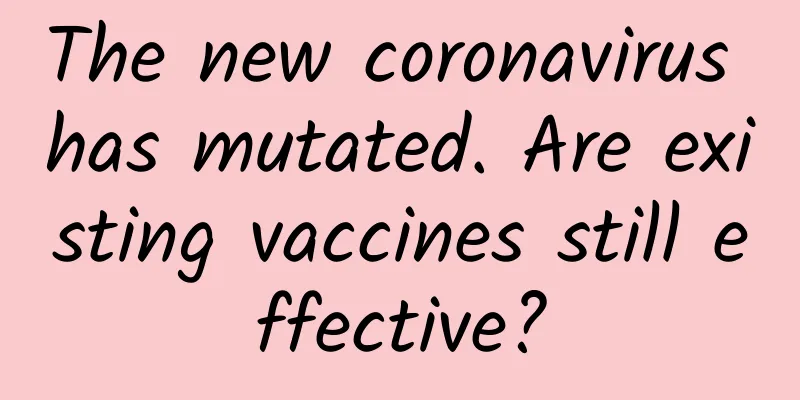The new coronavirus has mutated. Are existing vaccines still effective?

|
Experts say that by the end of this year, 70% of people in my country will be vaccinated against COVID-19. Photo from Xinhua News Agency/Photo by Zhang Chenlin READING Since the release of the genome map of the new coronavirus (SARS-CoV-2), more and more information on variant strains has been made public. The B.1.1.7 variant was first discovered in southeast England. As time goes by, more and more patients are suffering from COVID-19 due to this variant. Studies have shown that this variant has a stronger ability to spread and the risk of death associated with it is greatly increased. In the face of such a powerful virus variant, should we be worried that the vaccines we have received are still effective? Yesterday, Gao Fu, director of the Chinese Center for Disease Control and Prevention, also talked about the vaccine development and use strategies for virus variants at the 2021 National Vaccine and Health Conference. Gao Fu said that it is necessary to "consider ways to address the low protection rates of existing vaccines," such as optimizing vaccination procedures and different technical routes. Written by | Xiao Ming Editor | Ye Shuisong 01 The genetic code of the new coronavirus is prone to errors during replication. According to statistics, it accumulates an average of 1-2 nucleotide mutations per month during its spread, resulting in a new mutant [1]. Although we do not need to worry about most mutations, some mutant strains that are of public health concern may appear during the pandemic. The new coronavirus variant B.1.1.7 that appeared in the UK is spreading wildly around the world. Source: NIH In September 2020, the new coronavirus variant VOC 202012/01 (lineage B.1.1.7) was first discovered in the UK. Less than three months after the variant was discovered, in November 2020, cases of COVID-19 caused by this virus dominated in London and southeast England and spread rapidly around the world. Compared with the original generation of the novel coronavirus, the B.1.1.7 mutant has 17 mutations in its genome. Among these 17 mutations, 8 are in the sequence encoding the spike protein. In addition to N501Y (the amino acid at position 501 of the spike protein changes from asparagine to tyrosine, which makes the virus more likely to bind to the ACE-2 receptor of human cells), the mutations that have a greater impact on pathogenicity also include the deletion of amino acids at positions 69 and 70. These mutations increase the virus's ability to infect [2]. In addition, since nucleic acid testing mainly targets the "S gene" of the new coronavirus (the gene encoding the spike protein), wrong results may be obtained when conducting routine nucleic acid testing on patients infected with this mutant (there are now means to specifically detect this virus variant). Figure A, mutation information generated in the B.1.1.7 mutant genome; Figure BC, as of January 2021, the B.1.1.7 mutant has been detected in 49 countries/regions including the UK. Image from reference 3 Recently, clinical research results have shown that the B.1.1.7 mutant is not only more contagious than previously reported coronavirus mutants (the transmission rate is 43% to 90% higher than that of existing mutants), but may also lead to a higher mortality rate (for men aged 55 to 69, the risk of death from infection with the B.1.1.7 strain is 0.9%, while the mortality rate from infection with the original coronavirus strain is 0.6%) [4-5]. Another study published in the British Medical Journal at the same time also showed that the B.1.1.7 mutant caused a 64% higher mortality rate than the earlier variants[6]. The results of these studies coincide with each other. Of course, the B.1.1.7 mutant was also present in the United States, which was hit hard by the epidemic. It swept all 50 states in a short period of time. As of April 6, 2021, the B.1.1.7 mutant had caused 16,275 cases of infection in the United States. This number was far ahead of the number of cases caused by the B.1.351 variant from South Africa (causing 386 cases of infection) and the P.1 variant from Brazil (causing 356 cases of infection) [7], which also indirectly reflects the extremely strong infectiousness of the B.1.1.7 mutant. The infection caused by the B.1.1.7 mutant became dominant among all mutant strains in a very short period of time (USA). Data source: CDC 02 Since the novel coronavirus sequence was first published in January 2020, in less than a year and a half, many novel coronavirus mutants have been reported around the world. Among all the mutant viruses, more than 10 mutants have once again sounded the alarm for world public health. It has to be said that every mutation of the novel coronavirus has the potential to make it more dangerous and cause people more worries. The birth of a super mutant virus may cause pharmaceutical companies and scientific research institutions around the world to re-enter a new round of battles. From the perspective of world public health security, is this a bit sensational? The new coronavirus mutates so quickly, and some of them are extremely dangerous mutants. Will the vaccines we are currently vaccinated with lose their effectiveness when the virus mutants arrive? Recently, there have been a lot of news headlines such as "The virus is mutating rapidly, and the current vaccines may be ineffective!" that have caused panic among some people. Are these news stories rumors? Should we question the effectiveness of vaccines because of the arrival of virus mutants? Next, we will use some specific data to make a simple explanation of this issue. On March 11, 2021, Pfizer, BioNTech and the Israeli Ministry of Health jointly released a report that collected monitoring data from the Israeli Ministry of Health from January 17, 2021 to March 6, 2021 to explore the effectiveness of the vaccine. Here is a clarification: the BNT162b2 vaccine jointly developed by Pfizer and BioNTech is the only COVID-19 vaccine available in Israel. The more contagious and lethal B.1.1.7 variant of the new coronavirus is one of the main viruses causing the epidemic in Israel (more than 80%); the vaccination population this time is mainly people over the age of 16, covering a population of more than one million; the data analysis period starts 7 days after the second dose of the vaccine [8]. Pfizer and BioNTech have put in a lot of effort to explore the effectiveness and safety of the vaccine, so what are the results? The results showed that for symptomatic cases, two weeks after the second dose of the vaccine, the number of COVID-19 cases, severe cases and deaths decreased by at least 97% compared with the control group. In addition, the analysis found that the vaccine was also 94% effective for asymptomatic infections (regular nucleic acid testing was not performed, only incidence statistics were conducted). The report also stated that when analyzing the data, due to the limited number of infections caused by the B.1.351 virus variant, it is not possible to evaluate the effectiveness of the vaccine against this virus variant. Because the immune system produces antibodies against multiple parts of the coronavirus spike protein, there is a high possibility that the vaccine will remain effective against this viral variant, and the above statistical analysis is sufficient to prove this. But medical workers say immune-escape variants could emerge over time, and that progress could accelerate if some necessary public health measures are not implemented. This also reminds us once again that even though China's epidemic prevention and control work has been done very well, the disinfection of public places and the wearing of masks cannot be relaxed. Can China’s five existing new coronavirus vaccines still maintain their effectiveness when facing these virus mutants? We cannot find the answer from the current data. So far, although China has vaccinated more than 100 million doses of the new crown vaccine, the domestic epidemic has basically ended, and most of the vaccinated people are healthy people who do not carry the new crown virus (so far, the cumulative number of confirmed cases in China has reached 100,000, and more than 90,000 have been cured). In addition, the domestic prevention and control of the epidemic is very strict, so there are too few cases for comparison. However, although similar statistical work cannot be carried out in China, domestic vaccines have been widely used in several other countries. We can also refer to the ideas of Pfizer and BioNTech and conduct data surveys in these countries to clarify the true performance of our domestic vaccines. Five new coronavirus vaccines have been approved for sale in China. Source: Beijing Daily Client Although the new coronavirus mutates so quickly, we don't have to worry too much based on the existing data and the safe public health environment in China. At the same time, vaccination and subsequent research and development work cannot be relaxed and still need to be promoted. In addition to actively getting vaccinated, we must continue to remain vigilant against the epidemic and not relax at all. With the joint efforts of the country and the people, we can establish "universal immunity" as soon as possible and defeat the epidemic. Recently, a vaccine expert said that by the end of this year, 70% of people in my country are expected to be vaccinated with the new crown vaccine. Even if the epidemic rebounds, a relatively good immune barrier can be established by then. References [1]https://nextstrain.org/ncov/global?l%20=%20clock [2]Kemp SA, et al. SARS-CoV-2 evolution during treatment of chronic infection. Nature. 2021 Feb 5. [3]Grubaugh ND, et al. Public health actions to control new SARS-CoV-2 variants. Cell. 2021 Mar 4;184(5):1127-1132. [4]Davies NG, et al. Increased mortality in community-tested cases of SARS-CoV-2 lineage B.1.1.7. Nature. 2021 Mar 15. [5]Davies NG, et al. Estimated transmissibility and impact of SARS-CoV-2 lineage B.1.1.7 in England. Science. 2021 Mar 3:eabg3055. [6]Challen R, et al. Risk of mortality in patients infected with SARS-CoV-2 variant of concern 202012/1: matched cohort study. BMJ. 2021 Mar 9;372:n579. [7]https://www.cdc.gov/coronavirus/2019-ncov/transmission/variant-cases.html [8]https://www.businesswire.com/news/home/20210311005482/en/ Pattern Editor | Mr. Morgan Sai Enlightenment, Exploration, Creation |
>>: Can a 4K TV be used as a monitor? What does the 4K TV broadband requirement mean?
Recommend
Normal amount of progesterone in IVF
As we all know, nowadays with the deterioration o...
How to eliminate the pain of lumps during breastfeeding
Many mothers often encounter some complicated pro...
Is the uterus on the left or right?
The uterus is the most important and miraculous o...
Does ovarian cyst affect menstruation?
The appearance of ovarian cysts will definitely a...
What causes female urination?
Urinary incontinence is a common disease in daily...
Can the fruit of the cycad be eaten? How to grow the cycad?
Cycas revoluta is a gymnosperm plant belonging to...
Can you still eat the leftover food from the Chinese New Year? Does it really cause cancer? Tell your parents right away
Expert of this article: Fu Shufang, Master of Foo...
What are the symptoms of rheumatism in women
The main symptom of rheumatoid arthritis in women...
Is it easy for pregnant women to have miscarriage if they eat red dates?
Pregnant women need to pay special attention to w...
When is the best time to do moxibustion? Can I do moxibustion on rainy days?
The specific time of moxibustion should vary from...
Why do breasts get bigger during menstruation?
Some women don’t know that their breasts will bec...
What's the matter with the strong reaction in the third month of pregnancy
Everyone's reaction to pregnancy is different...
Squat or sit, which way do you choose when going to the toilet? | Science Spy
At the beginning of today, Fat Ke would like to a...









